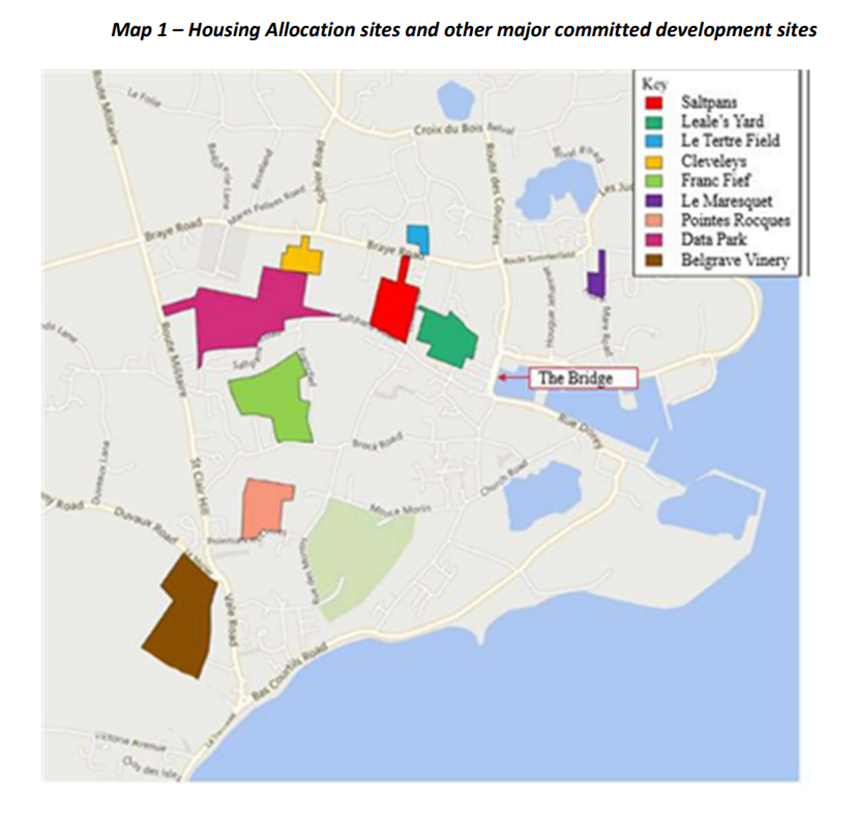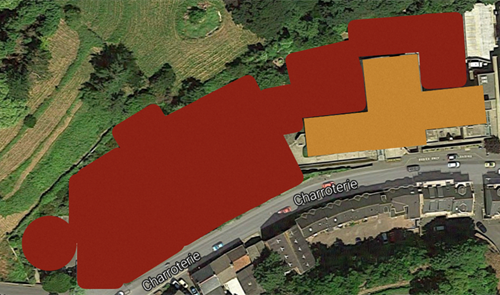Cumulative effect of building in north previously not taken into account, Environment confirms
Wed 05 Apr 2023

A map of the housing allocation areas in the Bridge area: this is the area E&I wants to focus on to improve transport connectivity and options for people already living/working in the area, and support new residential development that is likely to come forward.
Deputy Lindsay de Sausmarez made this clear because neither planning legislation nor policy requires the Development and Planning Authority to take into account the cumulative effect of developments. Deputy de Sausmarez said that although there were good reasons for that, to facilitate the building of badly-needed new homes, it did mean the impact of such development on localities inevitably wasn't taken fully into account. But that is now changing, with an area-wide approach underway.
She met Mr Leale to update him on progress on the WSP Mobility Plan for the north of the island, which is expected to be released later this year. As part of its planning for the Fontaine Vinery development, the Guernsey Housing Association, working with E&I, commissioned consultants WSP to carry out a mobility survey for the north of the island, the scope of which goes as far south as the Longstore.
Deputy de Sausmarez was asked why the plan, which seeks to improve transport choice all round, including through enabling more active travel, public transport and shared mobility (such as car clubs), was necessary. She accepted that the amount of development in the north, where transport infrastructure is already under a lot of pressure, meant steps had to be taken to try to mitigate the effects of that building and improve quality of life for those already living there.
"This isn't unique to the Vale and St Sampson's, as it affects much of the island," she said, "but I accept it's regarded as a particular issue for the North."
Cars – all about choice
"I know I've been labeled by some as anti-car but the fact is I’m a full-time working mum of four young children, so I totally get the fact that some car journeys are essential,” she said. The central issue, however, was the sheer number of vehicles in the island and the space they take up – when space is in short supply.
Environment & Infrastructure has been discussing this with Guernsey's builders and developers. The island has 86,000 registered vehicles for its population of 63,000 giving it one of the highest ownership ratios per head in the world. Although most carry just one person each and are parked 95% of the time, they still have to go somewhere.
Each stationary or parked car takes up nearly 12sq metres plus manoeuvring space, which means the number of vehicles in the island covers an area equivalent to more than 250 acres, land which is therefore not available for housebuilding.
"The point we've been making to the building industry is that the space footprint for two cars plus manoeuvring room is very nearly the same as you need to build a small apartment," said Deputy de Sausmarez. The "loss" of building land to cars was illustrated by the recent proposal to use Frossard House for housing.
 The image below shows in yellow the footprint of the offices themselves, the economically productive area, while several times more is economically unproductive parking that could be homes for nurses or other key workers.
The image below shows in yellow the footprint of the offices themselves, the economically productive area, while several times more is economically unproductive parking that could be homes for nurses or other key workers.
"We remain firmly pro-choice when it comes to transport," Deputy de Sausmarez said, "because the more choice people have, the less dependent they’re likely to be on car use alone and the better it is for the island. More options will reduce the pressure on our very limited space and ultimately make both transport and housing more affordable. This means we can keep – or potentially even re-introduce –vital green areas in our urban environments."
For instance, she said, each shared vehicle negated the need for 20 privately-owned vehicles.
Mr Leale said he was extremely grateful to the E&I president for the update and looked forward to the forthcoming Mobility Plan and discussing it further.
"The fact remains, however, that by cramming in so many new houses into the north without joined-up planning, we're always playing catch-up with the effects of that, be it congestion, parking or overloaded junctions.
"It will be very interesting to see how or if the new mobility plan has practical solutions to that."

